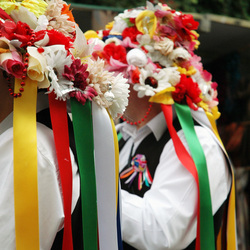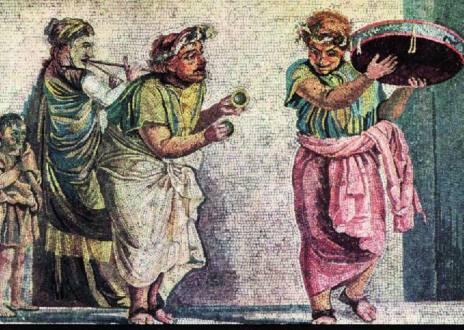Its origins are rural, the history of which is difficult to ascertain because it has been handed down from generation to generation, lacking written documentation and historical references. Some authors, among them José María Caballero Bonald, say that the Fiesta is Archaic and Moorish in its origins.
“The Fiesta of Verdiales is an Archaic musical monument, a cultural jewel of Málaga. More specifically, it is a sacred relic of a very remote Mediterranean past, which lives on in the music, song, dance and hats adorned with flowers linking the Fiesta of Verdiales with nothing less that the remotest religious cults of earth goddess and sun. Perhaps it’s greatest achievement is that it has been able to survive for millennia, stubbornly resisting successive invasions and colonization that have destroyed almost all signs of the ancient culture and history along the coast and mountains of Málaga. After the Visigoth invasion and colonization of the Byzantines, the Islamic colonization and subsequent conquest of the Christian Castilians, the only ancient signs of Malagueno history and identity that remain are its wine, raisins, small limed-white villages perched in its costal mountains and The Fiesta of Verdiales.”
Although ancient elements exist in other strains of European folk music, the Fiesta of Verdiales seems to be the only multi-millennium rural music and dance in existence in Europe. If nothing else, unique as a country orchestra that has survived for
Looking at the history of Verdiales, Miguel Romero Esteo says that it is clear that it is a very refined Archaic ritual music and dance, not merely a crude peasant invention. It is refined in that it is connected to astronomical calculations related to the cycles of the sun, the winter and summer solstices. The melody is of a Dorian modality. The Dorians were an enigmatic people, Mediterranean navigators, ancients that were eventually Hellenized and more or less converted into Greeks. For Plato in the 5th century BCE, the modality of Dorian music was the most beautiful and civilized made possible by several centuries of music behind them.
José Luque Navajas points out that Verdiales started to have an apparent Christian motif when they began to meet and play together during the Catholic calendar dates such as Christmas, Feast of Holy Innocents and the Day of San Juan, which correspond to the winter and summer solstices, directly referring to their pagan origin with pre-Christian customs.
Regarding the antiguity of Verdiales, Navajas says that it precedes Flamenco due to the fact that its form is more antiquated than the primitive Flamenco fandango of Málaga. The difference is seen in the percussion and string accompaniment. The rhythm is carried by a pandero (large tambourine type drum also used in antiquity), two or more pairs of platillos (small brass cymbals) and several palillos (castanets smaller than those used in flamenco.) The violin leads the melody, accompanied by two to four guitars. Also a lute and/or bandurria are used in the Comares style, also functioning to carry the melody. These two latter instruments denote the Arab influence in the Comares style. Flamenco song on the other hand is accompanied by guitar and clapping. In the Fiesta of Verdiales, song is a vital component and it is intended to be accompanied by dance, where the brilliance of the singer, together with the richness of the instrumental accompaniment, is specifically for dance.
Julio Caro Baroja says that the Fiesta of Verdiales has pre-Roman ancestral origins evidenced by the fact that the most important celebrations coincide with the solstices.
In earlier Verdiales, instead of a violin, the rabel, a three-stringed Spanish medieval instrument of Arab origin was used. The pandero was widely used and in antiquity, documented, among elsewhere, in it’s appearance in representations of the goddess Cybele. Identical brass cymbals, platillos, have been found in Asia Minor, from Hittite Anatolia dated at 2300 BCE.
During performances, in the Montes and Almogía styles, the scene is complete with the figure of alcalde or director waving a wand to designate the singer and to authorize the start and end of the piece performed. The abanderao walks with the alcalde ahead of the band dancing with a flag of the region or figure of a patron saint. Until relatively recently it was also a custom to sound a conch shell adorned with colorful ribbons to announce the arrival of the group to the nearby farmhouse (cortijo) or tavern (venta). Hats adorned with flowers and ribbons are also part of the accoutrements of the Fiesta, as it is referred to by those who practice and celebrate Verdiales.
The song is always a 6-line couplet whereof the first line is repeated in the third line, and/or the last line is repeated in succession. Again, dance is an important element of verdiales completing the fiesta.
There are three styles connected to three areas of the mountains of Málaga: Comares to the east in La Axarquía, Montes, directly north and east of the capital and Almogía north and more westerly. In the region the Fiesta served an important function in an environment of dispersed farms and small villages.
In the argot of the musicians, singers and dancers, the performances are referred to as la Fiesta and the group is called Panda (de verdiales). Each selection of a performance consists of three to four songs. In the Montes and Almogía styles there are competitions when different pandas meet. Those who watch and listen to performances may also join in. Participants call themselves Fiesteros or tontos (clowns). The major festival takes place on the 28th of December, the feast of the Holy Innocents, but also coincides with the winter solstice and the passing of the darkest time of the year.
There are different theories of the origins of the Fiesta of Verdiales, but many agree that we are dealing with millennium-old traditions informed by the most ancestral roots of Mediterranean culture and thereby the most ancient European. The Fiesta can be traced back to the winter-solstice celebrations of Dionysian cults and Saturnalia in the classic period.
The term Verdiales is also the name of the olive specific to the Málaga area (from Latin viridis, green, vigorous, young, alive). The olive stays green even when ripe. However the music seems to be more connected to the muscat wine, which is grown in the area, rather than the olive. This points to its connection the Dionysian cult.
It is also reflected in the custom of traveling musicians, following a predetermined path and taking donations, in the last days of December. This is when the groups of "fools" go out after the solstice to perform, play, do tricks and take alms. At that time the typical look of striking hats with ribbons, flowers and mirrors was linked to the ancient festivals of madmen who lavished in the cathedrals of Europe during the Middle Ages, until this was banned.
The enormous wealth of this folkloric expression from remote times is still alive today. Due to the fact that it retains its melismatic and instrumental diversity this contests that the Fiesta of Verdiales is one of the oldest, attractive and well preserved strains of folk music that can be heard in Spain and Europe today.
There is a mosaic, found in the ruins of Pompeii, now in the Archaeological Museum of Naples, by Dioscorides of Samos from the 1st century BCE called "Scene of Traveling Musicians". Depicted in it are musicians playing: a conch shell, used in the pandas until fairly recently, another playing a double flute or ancient Greek aulos, proper to mystery cults, and, perhaps most astonishing, a musician playing a pair of platillos, percussion cymbals, identical in size and shape to the ones current used by Fiesteros today, as well as those found in Anatolia in the 3rd millennium BCE, and finally, one playing a pandero or large tambourine adorned with ribbons. The head ornaments of the musicians in the image are reminiscent of the ribboned hats with mirrors and flowers used in
Francisco Molina Gámez writes that today there are similar Fiestas in Cyprus and Lebanon, and that certainly a thorough investigation would reveal surprising relationships.
In short, we can consider the Fiesta of Verdiales to be a living relic of a more remote European folklore focused around the Mediterranean, a jewel in the Mountains of Málaga, and other nearby areas, that has been able to be preserved and maintained through families in an almost miraculous way, to the pride and satisfaction of those who perform, live and feel it, and for those who are fortunate enough to see and hear them today.
Special care and dedication to conservation is needed today in order to maintain and disseminate in all its facets this folkloric wealth and heritage. This could be accomplished through comparative studies with other expressions of folk music and groups of festive ritual still present in Europe and the Mediterranean. This would be valuable not only from the standpoint of cultural tourism, but also for a better understanding of the deeper foundations of European culture.
All effort to conserve the Fiesta of Verdiales constitutes a great step to its permanence for centuries to come such as has been the case until now. This is without a doubt, among others, the responsiblity of cultural institutions in a time of complete absorbtion of culture and tradition by consumerism, corporatism and its homogenizing effects, but most of all it is the responsibility of the Fiesteros, as the participants of the Fiesta of Verdiales, to continue their efforts in any way possible.
Much of this article is an ever so brief summary of the research, in Spanish, of Francisco Molina Gámez as well as information supplied on the website for the Federation of Pandas of Verdiales: http://www.fiestadeverdiales.com/ (also in Spanish)
I’ll close here with a sample of la fiesta de Comares:
by Rudy Vigil






 RSS Feed
RSS Feed

